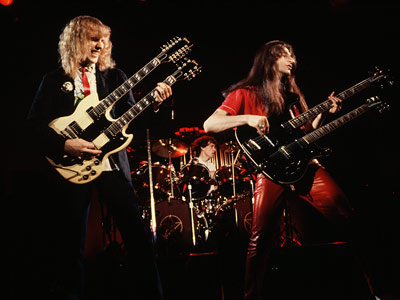 I’m not here to debate Guns N’ Roses. Since we’ll never know what the White Stripes might have sounded like with someone like Vinnie Colaiuta, their title remains intact: no band ever benefited more from a technically inept drummer, and suffered more by replacing him with a capable one.
I’m not here to debate Guns N’ Roses. Since we’ll never know what the White Stripes might have sounded like with someone like Vinnie Colaiuta, their title remains intact: no band ever benefited more from a technically inept drummer, and suffered more by replacing him with a capable one.
Our topic will not be the Red Hot Chili Peppers, whose relationship to their guitar players resembles a doomed, desperate Hollywood romance where one true starlet’s love is fleeting, and her replacements inevitably pale by comparison. We can only guess how history would have judged them if they were allowed to make the late-90s’ Prodigy-style electronica album that they wanted instead of Californication.
No, after reading this NPR article on who was left off the list the Rock and Roll Hall of Fame inductees, I had to write this about Rush.
I see some of you flinching at your screens, and I understand. Rush is a rock and roll band that is not fit for rock and roll cool. There’s a kid in your elementary school who could crack wise, break dance and always had the best outfits; Rush was a future font typographer tracing the elfin alphabet from the insert sleeve of The Hobbit. They are not the charismatic and dangerous teen smoking cigarettes and putting their feet up on the principal’s desk; they are the A.V. club leader and future documentary producer who knows how to use the boundary mics. Rush is not McQueen from Bullitt, Dunaway from Bonnie and Clyde, Brad from Fight Club or Angelina from Girl Interrupted. They aren’t the Master of the Universe in a corner office who wears a watch that costs more than you make in a year; they are that slightly rumpled but oh-thank-heaven-it’s-him-not-one-of-the-others IT guy who can’t resist mentioning that the remake of “Battlestar Galactica” is a better show than “24” or “Lost”.
As a kid, I was introduced to Rush via early MTV’s live video excerpts from “Exit Stage Left” and tour footage supporting Moving Pictures. Even to my novice, untrained ears they sounded like people who had been playing together for decades, working out the kinks and finding ways to make everything fit just right. I imagine that a ten year old who discovers Rush now probably thinks the same way as it’s only become more factually true. This sharply contrasts with almost any popular, or cool, rock band’s aesthetic; no matter how professional or technically capable, the manner and feel of any cool band must be “we just got together in the basement a few weeks ago to start working out these tunes for the party.” Eddie Van Halen has spent five decades working very hard to sound amazing while coming across as hardly trying. Rush wants you to see every step and number carried over of their long division.
When discussing Rush’s annual exclusion from the Rock and Roll Hall of Fame, there are obvious story lines in all the arbitrary splitting of hairs. Rock critics who have pushed Patti Smith’s “Horses” onto unsuspecting open minds reportedly hold their noses on account of Geddy Lee’s strident voice. Oh, that busy drumming (from the VH1 anthologists who put together Keith Moon tributes)! Those science fiction song titles? “Red Sector A”?!? “Force Ten”?!? These would all be much more acceptable to The Academy if they were Daft Punk tunes that Kanye West mined for catchy samples.
Lost in these aesthetic debates are the sublime details. “Limelight” is a gorgeous song. It alternates its time signature naturally without feeling like a math-rock exercise. The analog synths swirl through their low pass filters and oscillators, Alex Lifeson plays it square and straight for his rhythm parts, then flips the script to get haphazard around the beats during his lead guitar break. Like “The Spirit of Radio”, the lyrics explore an ambivalence about the glory of rock and roll stardom a decade before Kurt Cobain would shout “here we are now, entertainers!” as he dropped a nuclear bomb on L.A.’s Sunset Strip and its thousands of aspirational glam metal careers and foil wrapped cucumbers.
Perhaps the Rock and Roll Hall of Fame is *not* a Hall of Fame for rock and roll music. It may just be a museum of aesthetic, of postures, archetypes, clothes, meaningful gestures rendered meaningless, and some inert powders that require watery nostalgia on our part to become meaningful. Johnny Cash’s middle finger photograph, Michael Jackson’s zipper jacket, Madonna’s fishnet top from “Lucky Star”, a backup-to-a-backup bass guitar of Robert Trujillo’s from the St. Anger sessions donated by Metallica – all that is missing is enough family seating and some passable American pub fare, and we could have the Cleveland franchise of a once-successful theme restaurant where I celebrated my eleventh birthday.
Next year, there will be induction speeches, some heartfelt comments and canned sentiments about the artists and all that their work meant and means. It will all sound so…important. For a style of music that once was defined as challenging orthodoxy, there will be a lot of ceremony.
Meanwhile, the three members Rush will continue on their 38th year of continuous writing, playing and performing together. Amps will be cranked, guitars loudly played, drums hit hard and very quickly, songs written, and audiences will be moved. Three longtime friends and an extended family of support staff will get to see each other and travel the world, and all that is required is for them to perform music they love. Athletes and warriors have traditionally had to be forced into retirement before they are inducted into their Halls of Fame. Perhaps Rush’s shortcoming is that they’ve never had any reason to quit.
